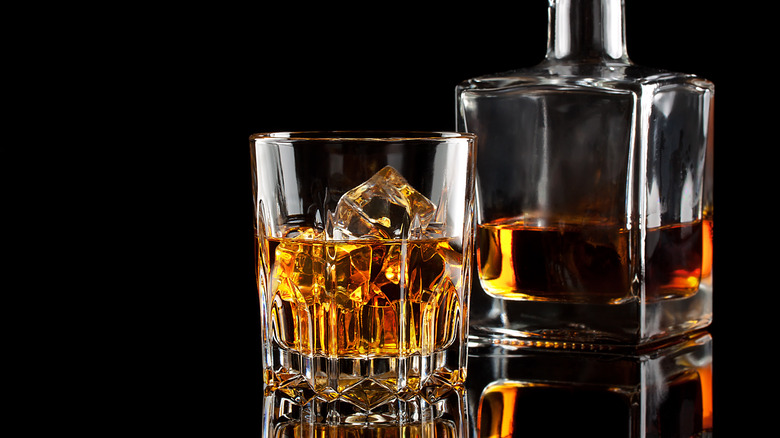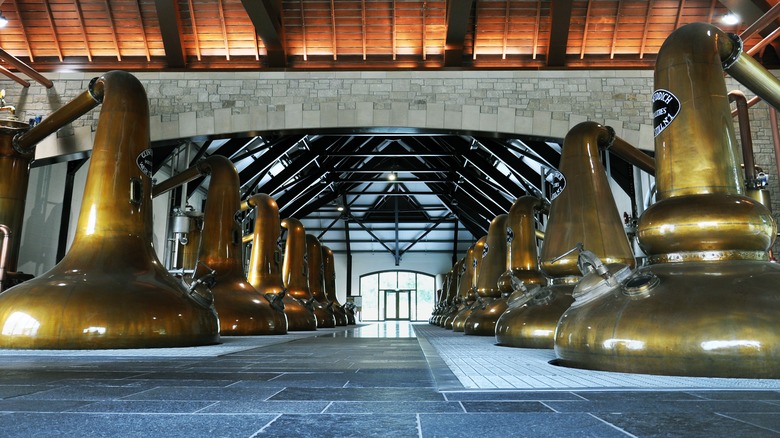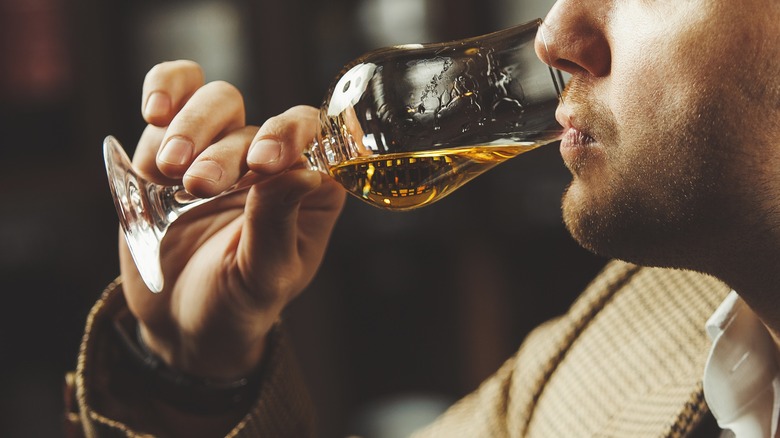What You Can And Can't Tell About A Whiskey By Looking At It
There's solid wisdom in the classic idiom, "Never judge a book by its cover." While we do this all the time in the regular course of life, when it comes to whiskey, we recommend taking this metaphor to heart, and being skeptical of what you can tell at a glance. Chris Blatner, Executive Bourbon Steward and creator behind @urbanbourbonist on Instagram, recently gave Foodie some exclusive tips about what can and can't be determined from eyeballing a glass of whiskey.
One of the first things most people notice when looking at the liquor is the color. From pale amber tones to a dark, chestnut hue, the spirit can take on varying shades of brown. Blatner notes this pigmentation is the least important aspect of a whiskey as far as its overall flavor and mouthfeel, but it can give you some indication of whether its gotten on in years or not. He says, "The color may give you some clues as to the age of a whiskey, with lighter whiskeys tending to be younger and darker whiskeys tending to be older" but that "it can be misleading trying to judge a whiskey by its color alone."
Barrel char during the aging process is the main culprit behind the liquor's appearance, and some barrels will make it turn darker in color. Whiskey with a no-age-statement can be lighter in color, but that's not always the case.
Filtration methods can affect the look of whiskey
Blatner also detailed how filtration can influence the visual presentation of whiskey. He told Foodie, "If it's very clear and bright it may indicate the whiskey was chill-filtered to remove fatty acid esters that may clump together and cause a haziness when the whiskey is chilled." Chill filtration is accomplished by dropping the liquid's temperature below freezing and passing it through filters that capture anything bulkier than several microns.
Esters are a combination of acids and alcohols. When the hydrogen atom from carboxylic acid is replaced by an alkyl group — ethyl, methyl, and propyl alcohol, and others — an ester is formed. These organic compounds impart fruity notes to the liquor but can also give it a cloudy appearance. While many distilleries opt to chill-filter their products to eliminate the haziness, some believe the esters are a defining element of the overall taste.
Blatner explains, "Whiskeys that are more opaque may retain some of these fatty acid esters which are often thought to retain some additional flavors in the whiskey and create a heavier or oilier mouthfeel." However, experiments have been conducted that show it is difficult to tell the difference in flavor between expressions that have been chill-filtered versus ones that haven't. Like most aspects of whiskey, this seems to be a matter of personal preference.
Color won't give you the full story of its flavor
While there are some broad assumptions you can make about a whiskey's taste based on visual characteristics, it's not a hard science. Paler varieties do tend to be less full-bodied than those with a mahogany color, but looks can be deceiving. Some distilleries even use caramel coloring to darken the spirit, and get away with it because it doesn't lend any flavor. Adding coloring is essentially a marketing gimmick to make the product appear darker and more flavorful, but it's a smokescreen to make the unbeknownst think the bottle is vintage. For example, some spirits, like bourbon (though not Scotch) forbid the inclusion of additives like caramel coloring in the end product.
A whiskey's flavor profile is complex, and disparate brands using various methods of fermentation, aging, and filtration result in a myriad of contrasting tastes. But everyone has different palates, which means the profile from a single malt you sip might be at odds with how somebody else tastes it.
As Blatner puts it, "Flavor notes in a whiskey are completely subjective and personal to each individual drinking it." The best way to discern the subtle flavors is to stop looking at it and learn to taste the whiskey like a pro.


